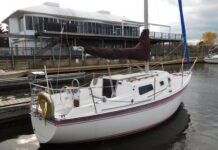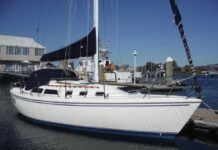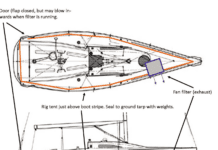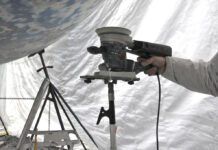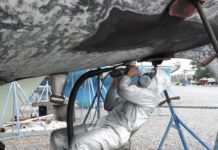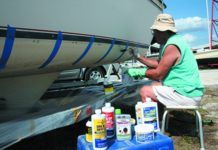Guest/Litton EPIRB Battery Replacement
Six years ago I purchased a Litton 406 EPIRB. It has a lithium battery which supposedly has a six-year service life and then must be replaced. I contacted The Guest Co., which apparently acquired the Litton EPIRB line, and they had me contact their authorized repair dealer, Mackay Communications of Miami. Mackay wants $452 plus shipping costs to service the unit. This includes replacing the battery, an O-ring gasket, testing, a battery disposal fee, and a new expiration date, all of which they say requires their technical expertise. They refuse to sell me just the battery.
I have gone back to Guest, and they too refuse to sell me just a battery. My reasoning for just wanting the battery is as follows: No special tools are needed to open the case. The O-ring is in perfect condition. The battery has a simple 3-pin female connector that plugs into a male connector on one of the circuit boards. As with most connectors, it can only be put together one way. The unit has a self test function.
While this probably only tests battery output, that is basically all that is needed. I don’t feel that a test of the transmitter should be necessary.The high initial cost of these units cannot be justified on the basis of the parts alone from which they are made.
Hopefully, what I purchased was an over engineered product with extremely high reliability. If after six years of non-use, it must be tested to see if it is still working, that isn’t saying much for the reliability. I can handle disposal of the old battery properly. I don’t need a new expiration date.
There are no requirements in the US or in any of the countries that I have been to in the Caribbean for me to carry an EPIRB. If I ship my unit to Miami from the Caribbean, where my wife and I presently live on our sailboat, we will be without its protection. There are probably a lot of other cruisers around the world like myself with EPIRBs with expired batteries.If our only choice is to pay an outrageous service fee, they like me will probably opt for sticking with the old battery until the self test indicates that it no longer works. Then we will buy a new EPIRB for a few hundred dollars more than we would have spent for servicing, and it most certainly wont be a Litton/Guest.
Being able to purchase a replacement battery for any piece of equipment should not be an unreasonable expectation.
-John D. Bitzer
Rodney Bay, St. Lucia
On board, we carry a Litton model 952-02 EPIRB. We have reached the expiration date on the battery (at least the expiration date as shown on the decal). We have unsuccessfully been trying to obtain a replacement battery, first through the Guest Company (who now owns the Litton EPIRB business) and through Mackay Communications, Miami, to whom we were referred by Guest. The response we are getting is that we must ship our EPIRB to their authorized service center to have the battery replaced-at $452.00 plus freight both ways. This is not an acceptable solution for a number of reasons. Most importantly, we are not willing to remove our EPIRB from our vessel. This defeats the original reason and purpose for having an EPIRB on board. If Guest, et al are saying that there is a liability issue involved with the consumer replacing the battery, let me state that it was we, the consumer, who made the voluntary decision to carry a 406 EPIRB; is it not our right to make the decision whether or not we are qualified to replace the battery?
-John & Melodye Pompa
Grenada, West Indies
We spoke by phone with Scott Thiemens of Mackay Marine. He told us that the EPIRB is considered a liability product that requires expert installation. Mackay installs, inspects, tests, and certifies the battery and EPIRB signal to SOLAS standards at a labor rate of $100/hr. According to Thiemens, a typical installation and test of the Litton/Guest battery takes 1.5 hours. Thiemens says that the replacement battery comes to Mackay at high cost, and that while Mackay is not a non-profit organization, their profit from battery installation is low.
Then we spoke to Jeff Johnson of Technical Support at the Guest Company in Meriden, CT. Guest has discontinued production of the Littons, but continues to provide support. Johnson confirmed that Guest regards the EPIRBs as liability products that require authorized representatives to replace and test the batteries and transmitters. He told us that the list cost of the Litton 952-02 battery is $330.75. The cost to the dealer is $236.25. Dealer cost of the 948 battery is $262.00.
So the requirement for authorized service is motivated as much by legal concerns as by mechanical ones. The argument that a consumer, having been careful enough to buy an EPIRB in the first place, should be considered responsible enough to maintain it, is falling on deaf ears at Guest, because, presumably, Guest doesn’t want to be sued if a consumer gets in trouble after making a mistake installing a replacement battery.
We can’t say that we blame Guest for that sensitivity, because people can and do make mistakes with the simplest of installations, and they can and do sue. Even so, it seems reasonable to suggest that an EPIRB owner should at least have the option to call Guest and receive a document to sign, in which they would agree not to hold Guest responsible for battery replacement problems. Owner signs and returns document with payment, Guest sends battery, owner installs it, and thats that.
Assuming that Guest wont necessarily leap to the same conclusion, we asked Jeff Johnson if there was an alternative to Mackay. He said that the cost of battery replacement for the Litton EPIRBs does vary between authorized service centers, and that owners can shop around between the following centers:
GSI Marine, 4016 Strawberry Rd.,Pasadena, TX 77504, 713/487-7800. Bay Safety, 2355 Kachemak Bay Dr., Suite 102, Homer, AK 907/235-7908. Offshore Suppliers, Inc.,413 N. Causeway Blvd., Metarie, LA 70001, 504/833-8251. Westpac Marine Services, Inc., 2316 S. Jefferson, Tacoma, WA 98402 253/627-6000.
We then called ACR Electronics of Fort Lauderdale, FL, a competitor of Guest in the EPIRB business, and found out that they use the same system: EPIRB battery replacement requests are referred to the boatowners nearest authorized ACR service center, and the service centers set their own rates. At press time we don’t know the cost of ACR replacement batteries, but we can assume they’re not cheap.
The lithium battery in one of these 406 EPIRBs is meant to last about six years in storage, and to transmit continuously for about 48 hours if activated. That makes for an obscenely expensive battery, but its not the whole story. When you buy a 406 EPIRB for peace of mind, youre also buying into a whole search-and-rescue system that, when activated, places people’s lives in other people’s hands, physically, legally, and bureaucratically. The high costs that coat-tail on that system and all those cautious relationships in the Age of Litigation are shocking, but shouldnt be surprising.
———-
Two-part Jib Sheets
I have a small Albin cruising sailboat. It has no winches. Nice not to bother with them. The main, being a multi-part tackle, is easy to deal with in any wind I sail in out here. The area is noted for light winds. The jib is another matter altogether. When the wind does come up, its tough to trim either the genoa or the working jib. I usually use the latter. Short of spending money and boring holes in my boat, is there a better answer than winches?
-George Shroeder
Seattle, Washington
There is, and its amazing that its not seen more often. Its a simple two-part tackle, quick-change system that cuts the grunt work in half .
Replace the jib lead blocks with blocks with a becket. Good choices are Racelites #RL-306, which come in two sizes; Schaefers #02-15 for attachment to your own deck hardware, or, if you want to get fancy, Harkens #2637 Black Magic Carbo AirBlock. The size of the becket is important.
Next, working on the clew-end of your jib sheets, get Racelite to rig a pair of RL-301-AR blocks on a #RL-326-AL shackle. Make sure the jaws of the shackle will accommodate the clew ring in both jibs. (If not, use a bigger shackle, maybe a Wichard #81432 keypin w/bar and captive pin.) Harken and Schaefer can do the same with their blocks.
Now youre ready for anything. In lighter air you can rig each jib sheet for single purchase by running it through a block at the clew and securing it there with a figure-eight knot or bowline. Lead the sheet through the jib lead blocks on deck, back to a cleat or cam cleat and youre in direct drive, so to speak. If the breeze kicks up, set up the lazy sheet by dead-ending one end on its deck-lead becket, then running the other end forward, through its block on the clew, then back through the deck-lead block to the cockpit. Tack the boat, take up the load on the two-part purchase, and set up the new lazy sheet the same way. When the wind lightens, reverse the process.
As with most things, there are disadvantages. You wind up with sheets about 50% longer than customary and the little blocks and shackle at the clew will be knuckle-busters- theyll make you think before you go forward when the sail is luffing.


